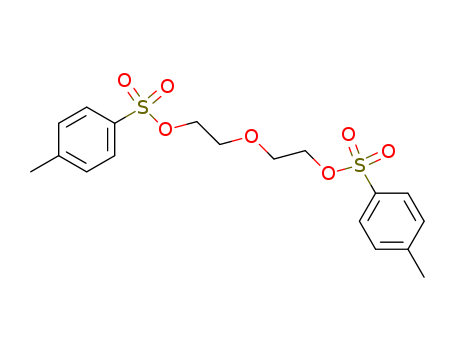- Chemical Name:Diethylene Glycol Bis(p-toluenesulfonate)
- CAS No.:7460-82-4
- Molecular Formula:C18H22O7S2
- Molecular Weight:414.5
- Hs Code.:2904100000
- European Community (EC) Number:628-596-3
- NSC Number:404215
- UNII:H92EG77LWH
- DSSTox Substance ID:DTXSID80996114
- Nikkaji Number:J211.393G
- Wikidata:Q72461890
- Mol file:7460-82-4.mol
Synonyms:7460-82-4;Diethylene Glycol Bis(p-toluenesulfonate);Diethylene glycol ditosylate;Oxybis(ethane-2,1-diyl) bis(4-methylbenzenesulfonate);Diethylene glycol di(p-toluenesulfonate);Tos-PEG3-Tos;2-[2-(4-methylphenyl)sulfonyloxyethoxy]ethyl 4-methylbenzenesulfonate;di(2-tosyloxyethyl)ether;Bis(2-tosyloxyethyl)ether;H92EG77LWH;Ethanol, 2,2'-oxybis-, bis(4-methylbenzenesulfonate);MFCD00026001;NSC-404215;2-{2-[(4-methylbenzenesulfonyl)oxy]ethoxy}ethyl 4-methylbenzene-1-sulfonate;2,2'-Oxydiethyl ditosylate;Bis-Tos-PEG2;2-(2-(4-METHYLPHENYL)SULFONYLOXYETHOXY)ETHYL 4-METHYLBENZENESULFONATE;C18H22O7S2;NSC404215;diethyleneglycol ditosylate;CBMicro_047760;UNII-H92EG77LWH;Bis(2-tosyloxyethyl) Ether;diethyleneglycol-di-p-tosylate;oxydiethane-2,1-diyl bis(4-methylbenzenesulfonate);SCHEMBL922407;Oxybis(ethane-2,1-diyl)bis(4-methylbenzenesulfonate);AMY4495;DTXSID80996114;Tos-PEG-Tos, MW 1,000;Tos-PEG-Tos, MW 2,000;Tos-PEG-Tos, MW 3,000;Tos-PEG-Tos, MW 5,000;Tos-PEG-Tos, MW 8,000;DI(2-TOSYLOXYETHYL) ETHER;Tos-PEG-Tos, MW 10,000;STK387255;2,2'-OXYBIS(ETHYL TOSYLATE);AKOS003617847;CS-W011664;DIETHYLENE GLYCOL DI-P-TOSYLATE;DS-2748;HY-W010948;NSC 404215;DIETHYLENE GLYCOL BIS(P-TOSYLATE);3-OXAPENTANE-1,5-DIOL DITOSYLATE;Bis[2-(p-toluenesulfonyloxy)ethyl] Ether;BP-20713;BP-26100;BP-26101;BP-26102;BP-26103;BP-26104;BP-26105;SY052010;BIM-0047971.P001;D2457;FT-0624888;DIETHYLENE GLYCOL DI-P-TOLUENESULFONATE;2,2-Oxybisethane bis(4-methylbenzenesulfonate);3-oxapentane-1,5-diyl bis(p-toluenesulfonate);Diethylene glycol di(p-toluenesulfonate), 98%;E10130;DIETHYLENE GLYCOL BIS(4-TOLUENESULFONATE);1,5-BIS(P-TOLYLSULFONYLOXY)-3-OXAPENTANE;A838176;SR-01000199114;J-520315;SR-01000199114-1;3-OXA-1,5-PENTANEDIYL BIS(P-TOLUENESULFONATE);BIS(.BETA.-(4-TOLUENESULFONYLOXY)ETHYL) ETHER;Oxydi(ethane-2,1-diyl) bis(4-methylbenzene-1-sulfonate);2,2'-oxybis(ethane-2,1-diyl) bis(4-methylbenzenesulfonate);ETHANOL, 2,2'-OXYBIS-, 1,1'-BIS(4-METHYLBENZENESULFONATE);2-(2-(4-METHYLPHENYL)SULFONYLOXYETHOXY)ETHYL 4-METHYLPHENYLSULFONATE;methyl?4-methyl-3-(4,4,5,5-tetramethyl-1,3,2-dioxaborolan-2-yl)benzoate;4-methylbenzenesulfonic acid 2-[2-(4-methylphenyl)sulfonyloxyethoxy]ethyl ester



 Xi
Xi


